From custom car parts to gaming figurines, demand for printing services is going through the roof. With a bit of planning, preparation, and strategy, you, too, can get in on the ground floor.
To operate a 3D printing business, you’ll need a 3D print “farm”, which is the name for a group of two or more 3D printers, ideally networked together. If you love 3D printing, then you may love having a 3D printing business since most of your time is spent keeping your farm operational and producing as many parts as possible.
Before you hit the “buy now” button on that large-volume printer you’ve been eyeing, it pays to take a step back and plan out your strategy. Know to whom you plan to sell your services in advance, because, let’s face it, there are a lot of places to get a 3D printed prototype or figurine. What will set you apart?
We asked several successful 3D printing service entrepreneurs this question and you can read their advice below. But first, let’s outline the basic first steps, how to decide what machines to purchase, how to get operational, and what potential costs you might encounter in your first couple of years.
Planning Your 3D Printing Business
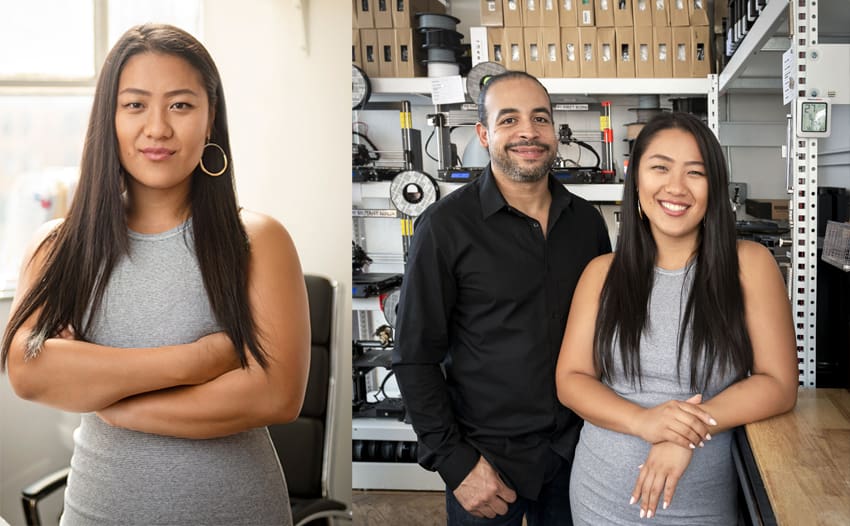
Like a real farm, a printer farm can quickly take up all of your time, whether you have it to spare or not.
To begin, ask yourself questions such as:
- Why do you want to run a print farm?
- Will this be a part-time hustle or a full-time job?
- Are you planning on making money? If so, how are you going to collect? If not, how are you going to cover costs?
- What extra services can you offer, such as custom 3D modeling, 3D scanning, painting?
One way you can find the answers to these and other questions is to make a business plan, which outlines the strengths and weaknesses of your idea. This covers everything from the people you are making products for to marketing and delivering the final product.
We won’t go too deep into the points of a business plan since many are universal to any business but some more 3D printer-related tips at this stage are:
- Find out who you want to make items for. Printing Dungeons and Dragons minis for your friends or for sale requires a different method and fewer quality concerns than face shields for front-line workers.
- Start out small. You don’t need to rent a warehouse before you make your first sale. Produce at your capacity, and focus on uptime (the amount of time the printer is actually producing) to give yourself an idea of what you can deliver on. Yet, plan to scale. Grow as you need to, ensuring you can always deliver on what you promised the client.
- Plan how to deal with obstacles before they happen. Brainstorm alternative strategies to common problems that might come up, such as your usual supplier running out of your go-to filament or increasing the price of the resin you need, one or more of your machines becoming inoperative, and so on.
Purchasing 3D Printers for Your Farm
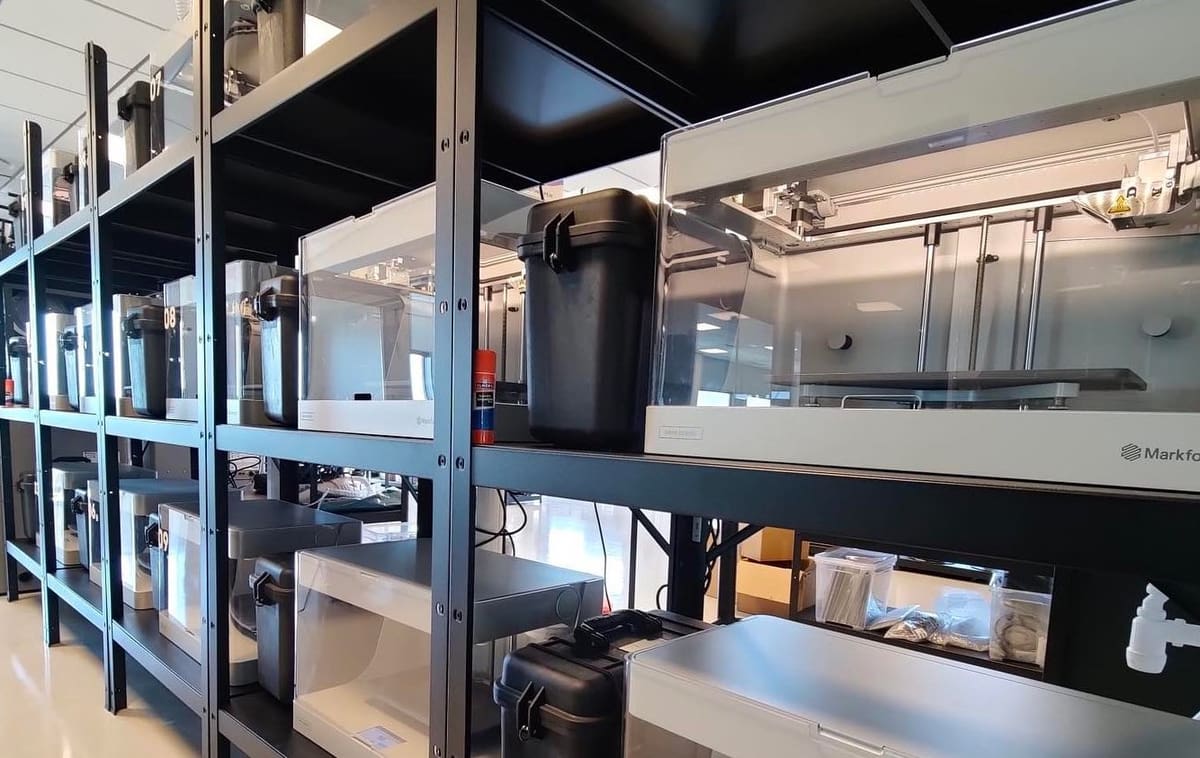
Although you won’t be buying house-sized assembly robots like a factory, equipment purchasing is at the heart of a print farm. Machines that require constant tweaking or that cannot produce in the materials you need could sink your business before it begins.
There are four main areas to consider when purchasing: compatibility, reliability, cost, and output capacity. Other important areas include software, spare part availability, energy usage, and upgradeability.
Pick the Fit-for-Purpose Printer
Simply put, will this printer meet your customers’ specific requirements? If a client needs a print made of food-safe PLA, a roomful of resin printers will be going to be useless. If the product is going to be put under significant strain, should you print in the toughest filament, or invest in an SLS printer? Try to uncover what your target customer will use the object for before you commit to purchasing a printer to create it.
Focusing on Reliability
Quality control can vary widely between manufacturers, models, and even individual units. Uptime, or the time spent actually producing, is essential to a business. From our experience speaking with small print farm owners, some of the most common machines are from Prusa Research, UltiMaker, Formlabs, Bambu Lab, Markforged, and Raise3D.
Calculating the Total Cost
Prices of 3D printers can change, so it can be difficult to know when to buy, but typically, a reseller will give you a deal if you buy more than one unit. Keep in mind that the sticker price of your machine is only part of the equation.
When it comes to estimating the amount of your final investment, consider the costs of materials, including whether or not you’re locked into buying materials from the manufacturer or can buy third-party materials. Consider if any additional equipment is required, such as a filament dryer or a wash-and-cure station for resin parts. Will you need to install special ventilation, sinks, or tables at your production location? Is the software that runs your printers an annual subscription? Then, of course, there are spare parts you’ll need.
Planning for Output Capacity
In manufacturing, volume is key. Every millimeter of print area you can use is a reduction in costs and an increase in profit, but a large-volume printer isn’t necessarily the best option. Imagine putting the print jobs of several customers on one print run and having a print failure ruins everything. Most small print farms print one part at a time unless they are duplicates.
Keep to the Same Ecosystem
Keeping things as simple as possible is a good rule for any business, and it goes double for print farms. Understanding the quirks of a single manufacturer is a lot easier than trying to remember which has what weaknesses. Keep your equipment to as few brands, makes, and models as possible to avoid unnecessary complications, having to have too many spare parts on hand, and having to train workers on multiple platforms. A good rule of thumb is to have one go-to brand for your printers, supplies, and add-ons, as well as one backup brand for each.
Operation of Your Print Farm
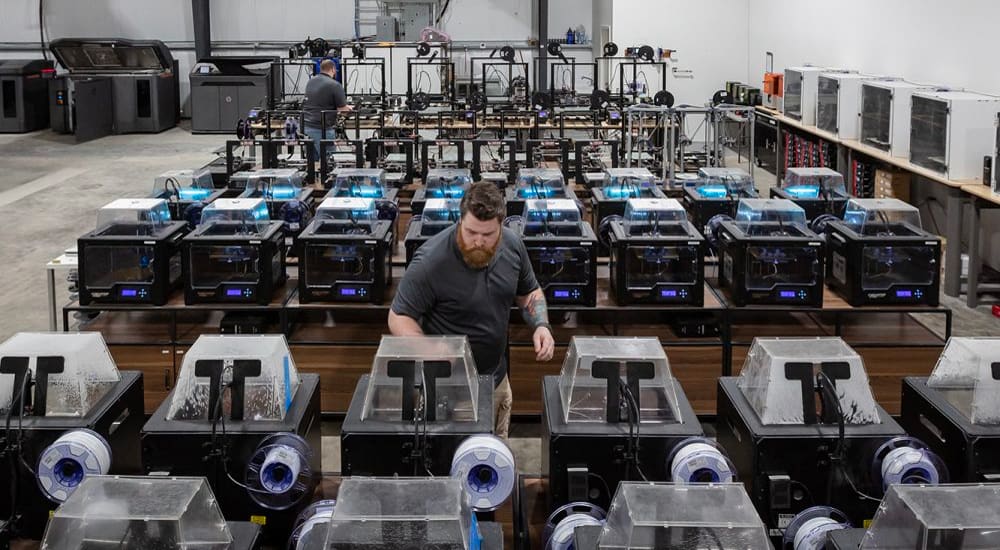
Anyone who deals with manufacturing will tell you that the actual product is the least of your concerns – it’s the machinery maintenance, wear and tear, software problems, and so on, that take up the bulk of your time. Minimizing these issues will be one of the most effective ways to ensure your business will survive and thrive, whether you’re just starting out or are well-established. Let’s take a look at some things to consider.
Planned & Regular Maintenance
The more complex a machine, the more things that can go wrong. Even if the machine is producing fine, it can throw a gear if it goes too long between maintenance times. There are a few simple things to look out for that are common to all printers, and some maintenance tasks that are good to perform regularly on FDM printers.
As 3D printers get easier to use and perform straight out of the box, the less an owner can fix and upgrade. Know what maintenance and upgrades are available for you to carry out and which ones may require you to send the machine to a service center.
Automation Software
Running a single printer by SD card can be tedious; running 10 is a nightmare. Luckily there are a variety of software packages to make the operation of multiple printers smoother by sending files to the next available printer, monitoring prints, and alerting you when the job is done, among other features.
Some 3D printer brands have networking software built in, such as Formlabs Dashboard, MakerBot CloudPrint, Ultimaker Digital Factory, and Markforged Eiger & Eiger Fleet.
Some programs to explore include:
- 3DPrinterOS
- OctoPrint
- Print&Go
- AutoFarm3D
Planning for Post-Processing
Aside from printing errors, the biggest issue facing 3D printing as a manufacturing tool is post-processing: clipping off supports, sanding down layer lines, and other finishing touches that take time and expertise. You want customers to get a nice finished product, rather than something that looks like it’s still in progress.
To make this go as smoothly as possible, plan for the space to carry out post-processing along with the tools to make it easier.
Packaging & Shipping
Packaging can be tricky, as printing can create unique shapes, including extremely delicate and fragile ones. If possible, slice and print these separately, and make sure they are packed as well as you can.
As for shipping, there are more specialized articles and websites to show how best to ship bespoke items. Choose the service that best suits your needs and your region, but be prepared to lose some products to a number of problems, such as incorrect addresses, shipping methods, or even “return to sender”. These things happen even to Amazon, but the longer you keep at it, the better you will become.
How Much to Charge For Prints
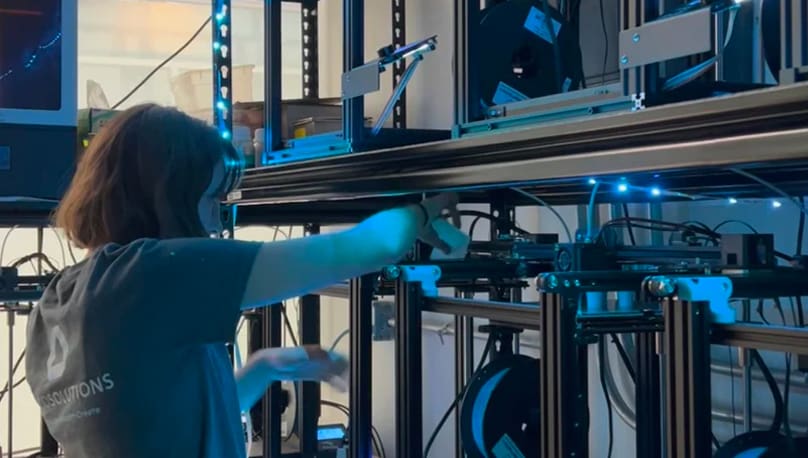
Even if you’re not charging money for your services, at the end of the day, a print farm acts like a business. Money is needed to supply filament, resin, electricity, and even maintenance. If it’s going to last any time at all, you’ll need to keep track of what you spend and budget accordingly.
Printed Part Costs
The biggest question print service entrepreneurs often have is what to charge for prints. There’s no universal answer except for that it depends on your business costs. Calculate those first and you can come up with the proportional part cost based on your time, expenses, and materials.
Luckily, there are 3D printing cost calculators. These calculators take in a range of different parameters with the goal of calculating a competitive price and leaving you with a profit.
Some of our favorite print cost calculators include:
Startup Costs
The most expensive time in any venture is right at the start, as you have to not only cover recurring expenses, but one-off costs like your first couple of printers, some rented floor space, a business logo, and so on. Keep track of these and compare them to future expense reports to see how much you’ve shelled out. There also needs to be money on hand for unexpected costs, such as needing to move your setup due to an uncooperative landlord.
There are many business loans specifically set up to cover startup costs, funded by governments, banks, or private organizations. You may even secure one to lease your first few 3D printers to get a jump start in your business.
Sunk Costs
Sunk costs are the day-to-day recurring expenses every business faces. The old joke is that they’re called sunk costs because they can sink your business. In particular, things like rent, marketing, shipping, and electricity can really add up.
Finding ways to minimize these while still delivering to your clients will be the success benchmark of your business. Calculate the cash-flow projections (potential earnings minus costs) to see where you can or should cut back on.
Breaking Even
This is probably the most crucial factor to consider: How many sales in a given time frame (days, weeks, months) do you need to simply cover all the costs of starting and running your business? This figure will be one of your most-referenced in your first few years of operation, so make sure to follow the steps in the business plan since it will give you all the necessary factors to start with.
Advice from 3D Printing Service Entrepreneurs
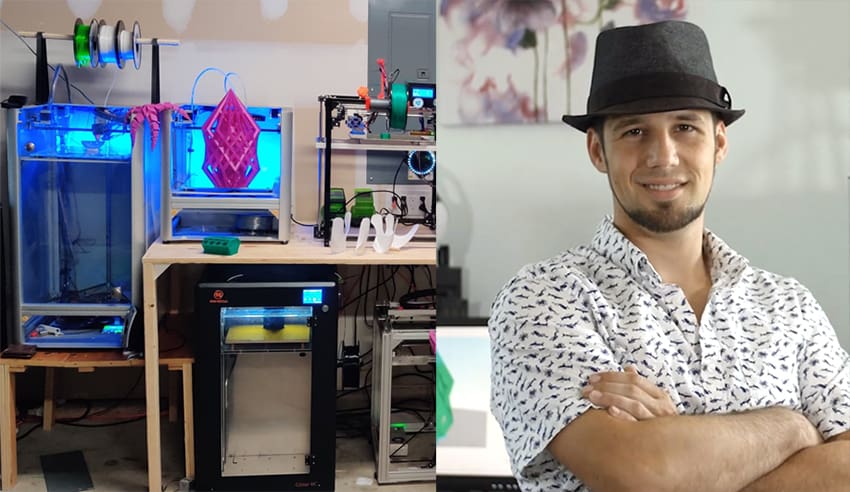
What do you wish you’d known before you got started with the print farm?
“I think I could have saved myself a lot of time if I had planned for growth from the start. I went from running one printer on a desk at my house to taking up an entire closet with printers, then half my garage, and then finally moving into a commercial space with lots of room for more printers. Each phase involved moving machines, running new wiring, figuring out the networking, and filament mounting and storage logistics, only to need to redo it all within a year each time.
“Also, I can’t stress enough the difference between printing something here and there for your friends on a handful of machines compared to managing even 10 printers, let alone 20 or 30. The time involved in little things like slicing models, uploading files, loading filament, cleaning plates, etc., all stacks up very quickly at that scale so any opportunities for efficiency are worth exploring.” — Justin Cockrell, Owner, Hudson Creative Group, Fort Smith, Arkansas.
What’s your top advice for 3D printing hobbyists who want to turn pro?
“My top advice is, find your niche, find your customer, and always keep trying to understand them and their needs. Yes, this is 3D printing, but at the end of the day, your marketing, customer insights, service, and targeting is what will get your business off the ground. Get yourself some research, market analytics, watch other companies and learn from their actions. You’ll soon attract a customer segment and then you can begin to strategize more ways to monetize it.” — Christina Perla, Co-Founder & CEO, Makelab, New York City
What has been your biggest lesson learned in the 3D printing service industry?
“You have to be prepared for changes, both in the technology and on the business side. This industry has grown so much and will continue to do so. New competitors will come in and undercut your pricing simply because the cost of entry is so low, but without fail, I’ve seen those competitors either disappear or raise their prices within a few months because those low margins just aren’t sustainable from a business perspective. So, weathering those storms by having varied revenue streams is critical to continued success, in my opinion.” — Justin Cockrell, Owner, Hudson Creative Group, a small 3D design, scanning, and printing business based in Fort Smith, Arkansas.
What hurdles might entrepreneurs face when trying to set up a 3D printing business?
“When people get started in 3D printing, some of the biggest mistakes are related to pricing and marketing. A lot of people start by just doubling the cost of filament and don’t realize that 1 or 2 failed prints will have you losing money very quickly. Then, when it comes to marketing, a Facebook or Instagram page is not enough. A Google business listing is very important for a service provider. Selling prints on platforms, including eBay, Etsy, and Amazon, is critical for being a store.” — Michael Lynn, Owner, 3D Print Everything, Fort Worth, Texas
How important is it to also offer design, advice, and complementary services?
“Only offering 3D printing without design and complementary services is something we see as unrealistic. Currently, more than 50% of customers also require design advice or assistance in some form. This could range from redesigning physical parts in preparation for printing to fixing existing data that might not be usable. Having a good knowledge of two to three different CAD systems is essential to help any customer with their design and data needs.
“Selling 3D printers along with resins and filaments currently accounts for up to 40% of our revenue. We are proud of the fact that two of the biggest manufacturers of 3D printers, Formlabs and Ultimaker, count us among their preferred resellers in Germany.” — Alexandra Bongartz, CEO, Beta2Shape, Munich, Germany
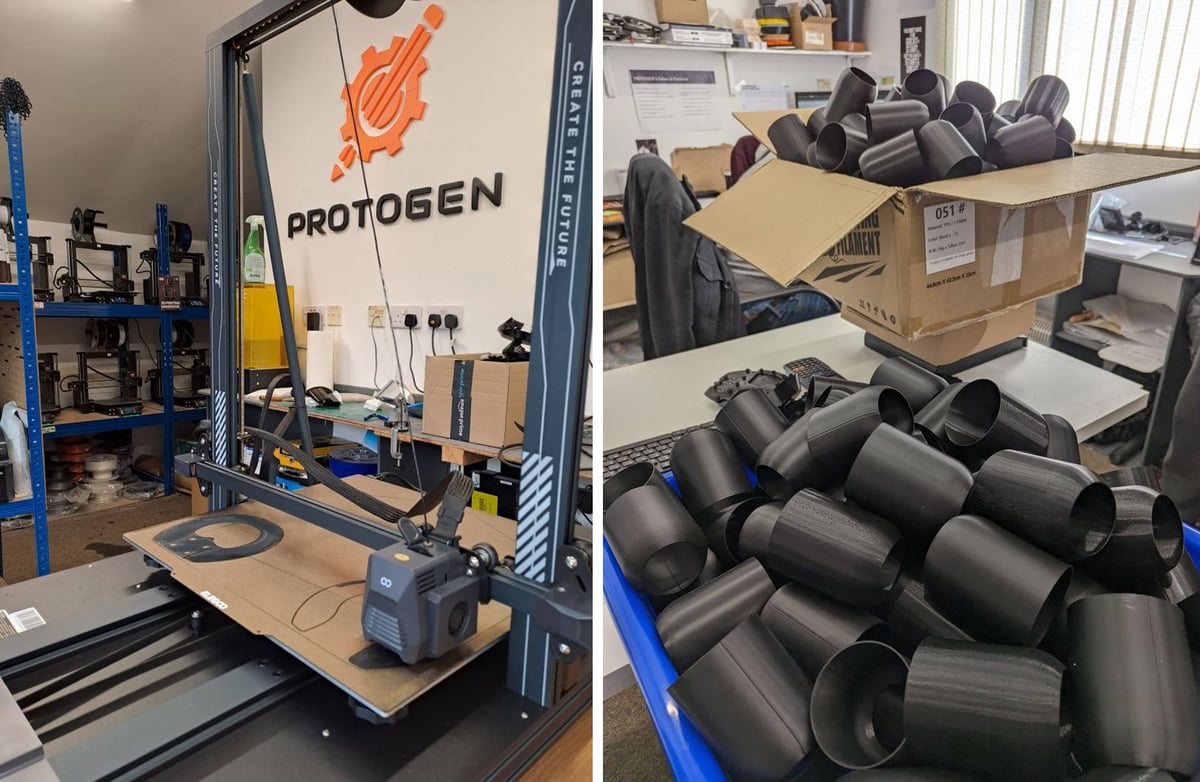
How do you differentiate your company from the competition?
“We differentiate by offering solutions, not just services. We contribute to our clients’ projects by offering ideas to make their projects even better, whether that is in the design, the production and printing method, or the overall concept. Our input and assistance is highly valuable, but it is not a line item that we charge for, it is just what we do. Customers are often unaware that they even need it, but when we start brainstorming with them to make their project even better, they certainly appreciate it.” — Josh Stover, Co-Founder, 3D Printing Tech, Atlanta
What are your cautions for hobbyists who want to turn pro?
“Read up on creating a business, find a mentor that you trust, be frugal, and work with what you have. A basic FFF 3D printer often works as well as the most expensive, industrial FFF machines. The difference is often that the cheaper 3D printers need a lot more maintenance and adjustments, but that should not be a big problem with low volumes. Put as much money as possible back into your business until you are where you want to be. I think that support from your family is crucial. You probably will have to work a lot of late nights and weekends the first few years.” — Lamin Kivelä, Owner, Xpanded Reality, Stockholm, Sweden
What were some hurdles in growing your business?
“3D printing is accessible, but with a low barrier to entry comes a high level of competition. Although 3D printing is easy to get into, it’s not easy to excel at. As a hobby with one machine, it could be a nice side earner. But if you want to scale it to a big business, you have to treat it like a big business, and it’s hard work.
For me, it was a good year and a half of constantly losing money on almost no salary. That’s not for everyone. A 3D print farm is a factory that has to make hundreds of different products every day so there’s problem-solving on every print bed, and if you have 100 machines, that’s 100 problems a day you have to solve. It’s not like injection molding, where you get the tooling made, you test one, and once it’s right, you run it 10,000 times. Instead, every machine could have different problems. And each print requires a level of unique thought and problem-solving. So it’s difficult work, but it’s out there, and if you want it, then you can get a machine and start in your living room just like me.” — James Birkett, Founder, Flex3D, Worcester, UK
License: The text of "How to Launch a 3D Print Farm: Tech & Business Tips" by All3DP Pro is licensed under a Creative Commons Attribution 4.0 International License.
